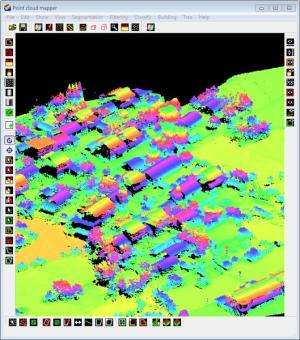Software capable of quickly producing 3-D building models

Researchers at the UT have developed software which enables users to quickly produce 3D models of buildings for relatively little money. 3D models are used for navigation purposes, training purposes, urban planning and safety, building maintenance and the fitting of solar panels, for example. The software can automatically generate 95% of the detailed 3D building models, thus reducing production costs and lead time. The software is based on research conducted by Biao Xiong, who obtained his doctorate at the Faculty of Geo-Information Science and Earth Observation (ITC) on 5 December. The software is already being used for the provision of 3D maps.
Current methods for producing 3D models are not an automatic process and often, this software uses aerial photographs or laser measurements to generate the models. These methods are expensive and time-consuming. Xiong developed software which enables its users to automatically generate 95% of 3D building models using laser data. The remaining 5% of modelling is manual work made efficient. The models of the buildings are very detailed and even depict dormers.
Xiong: "The software can be used by a wide audience. Municipalities and land registries can use the method, but companies may also find it interesting. A roofer may base his quotation on the 3D model of a roof, for example. For companies like Google this software is also very interesting. Google already has 3D maps at its disposal, but it is very expensive and time-consuming to generate those maps. They are not up to date, and constantly updating the entire collection would be too time-consuming. However, with our method, you can automatically update the maps for 95%. It only takes me a week to produce a 3D model of the entire city of Enschede with my laptop. We would, of course, need more people and computers to make a 3D model of the whole of the Netherlands, but that should be feasible within a month. Production costs are much lower compared to current methods, as most of the work is done automatically." Together with four colleagues, Xiong launched a start-up called Dipper: "Our aim is to develop easy-to-use applications." Xiong obtained his doctorate on 5 December: "Who knows, Sinterklaas may also be thrilled. He can use this model to see by which route to best reach the chimney," he jokes.
To generate the 3D models, the software makes use of laser data (LiDAR), which are measures taken from a helicopter or an aeroplane (such as those to be found in the Actueel Hoogtebestand Nederland, AHN2, the up-to-date collection of height data in the Netherlands). This data is freely available. The buildings are reconstructed from the point clouds in LiDAR data. Roof constructions are also detected using this technique. Next, elements of buildings are recognised by analysing roof constructions. The elements are then modelled into an entire building. If a mistake is discovered in the roof construction, it is automatically corrected thanks to the software's ability to recognise and memorise error patterns. This assures the quality of the 3D model. Assistant professor Sander Oude Elberink: "At Level of Detail 2 (LoD2), the 3D models are very detailed. This is a level of detail at which roof constructions, including dormers, can be modelled. This is an enormous improvement compared to the existing software generating models at Level of Detail 1. In comparison: LoD 1 is a level of detail at which each building is reconstructed in just one height, which leads to those building models only having flat roofs."
Provided by University of Twente




















